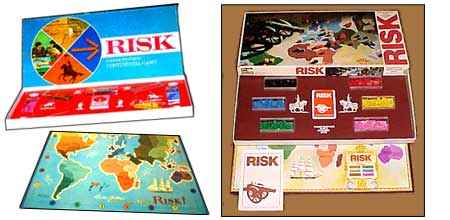Risk

Synopsis of Toy
We want the world, and we want it now. Lay out the board, parcel out the territories, build up the armies, and commence global conquest. Even people who “don’t play strategy games” know Risk. Simple enough for a young mind to grasp, yet elaborate enough to spawn strategy guides and ongoing “take North America first” vs. “he who holds Australia will one day rule the world” debates, Risk made world domination safe, affordable and fun (budding dictators, take notes).
Parker Brothers unveiled Risk in 1959, and though the contemporary world was embroiled in a Cold War, the company decided to go colonial with its game of conquest. From the point of Argentina in South America to the tip of Kamchatka in northeast Asia, the world was yours for the taking, but everyone else on the board had the same idea. Rules varied from year to year and even from country to country, but the basics remained the same: Countries were either divvied up with one-by-one choosing or by dealing out the country cards that came with the set. Once the world was owned, players built up their armies, adding defenses in some regions and preparing for attack in others.
Turn by turn, the face of the map changed. Player army cubes (later replaced by plastic icons, roman numeral figures or actual molded figurines) were pitted against their color-coded rivals, determining outcome by the roll of the dice. At the end of a turn, country cards were awarded to any player capturing a territory, and once a matched set was collected—three infantry, cavalry or artillery, or one of each—they could be traded in for bonus armies. On the game went until the map showed a unified globe under one conquering army.
Certain versions of the game allowed shorter play by assigning each player game-winning missions (knock out a certain color, capture certain continents, hold a set number of territories, etc.), but these were only the beginning of the Risk variations that would spring up in living rooms and college dorms across the globe. House rules added new twists to the format—everything from nuclear combat to multiple-earth play (on several boards at once, in one marathon multi-dimensional game).
Parker Brothers added its own new offerings—the Castle Risk board game, CD-ROM updates, etc.—but die-hard players have stayed loyal to the original. Political winds may shift and empires may be divided in the real world, but on that stiff cardboard map, the world is still up for grabs to the next Genghis Khan, Alexander the Great or Napoleon.
Release History of Toy
1959 - RiskSub Categories of Toys
gamesboard games
